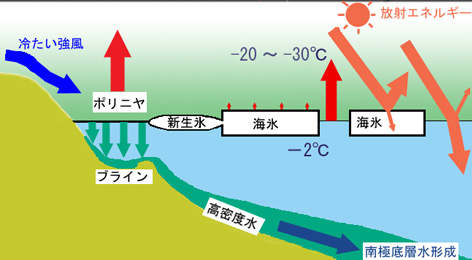Sea Ice Science
Sea Ice Characteristics and Their Impact on Climate
Due to the three characteristics below, sea ice has a large impact on atmospheric-oceanic systems (or, more broadly, climate).
- High Albedo(High reflectivity of sun rays)
Because sea ice is generally covered with white snow, 60-70% of the sun’s rays are reflected. By contrast, the black nature of seawater means it reflects merely 10%. Once sea ice expands, a large proportion of the sun’s energy is reflected and this results in cooling. This cooling results in additional sea ice expansion, thus forming a positive feedback cycle. In this way, it is possible for sea ice to change not only regional climates but also the global climate as well.
- Atmosphere-Ocean Insulation
Sea ice acts as insulation that largely suppresses heat exchanges between the atmosphere and ocean. Therefore, the absence or presence of sea ice and its changes have large impacts on atmospheric-oceanic heat transport. This process also involves a positive feedback cycle.
- Redistribution and Transport of Heat and Salt
When sea ice forms, water with high salt content (high salt concentration), or brine, is discharged and heavy water is produced which sinks to the ocean’s lower or middle depths. Most of the water comprising the mid-depth layer of the earth’s oceans has been created in regions where sea ice is produced. It is thought that if this product of water were to change, ocean circulation at a global scale would also change and create large climatic shifts.

References
The links below provide additional reference information.- Sea Ice Melting Mechanisms and Ice Albedo Feedback
- Sea Ice-Ocean Interaction Modeling
- Global Mapping of Sea Ice Production
- The Sea of Okhotsk Ice Forecasting
- The Sea of Okhotsk Ice Production and Middle Layer Circulation: The Impact of Warming
- Satellite-based Development of Sea Ice Algorithms
- High Precision Measurements of Sea Ice Thickness


